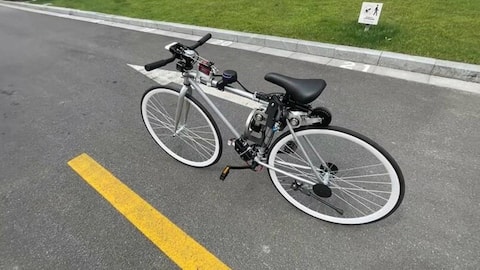Huawei engineer develops open-source autonomous self-balancing bicycle after an accident
What's the story
When we think of the uses for Artificial Intelligence in the mobility sector, we usually think of autonomous cars, right? But the implementations today are still in development and outside the financial reach of commoners.
However, a Huawei engineer drew from personal experience to design an AI-powered autonomous bicycle outfitted with sensors and actuators so it can balance and move by itself.
Here's how.
Loaded
Project began when lead engineer had accident on bicycle
The project's lead engineer Zhihui Jun began working on the project after he was injured in a bicycle mishap. Jun, a Huawei employee, and his colleagues used the company's technology to develop the bicycle.
The road bike is equipped with two brushless motors, steering gear, an RGBD sensor, an accelerometer, a gyroscope, a LiDAR sensor, and a model airplane battery to power the apparatus.
Using data
AI processing is handled by Huawei's Ascend 310 chip
The sensors gather data about the surroundings, identify objects, their distance, and the bicycle's relative position and speed.
The data is used to control end-effectors, including a motor to drive the rear wheel and a strong servo motor for steering.
The AI computation is handled by Huawei's Ascend 310 processor. Jun says the bicycle is now capable of perceptive thinking and decision-making.
Data
Model airplane battery keeps electronics running for around three hours
The handle-mounted RGBD (where D represents Depth) sensor quantifies the distance of objects ahead while the model airplane battery keeps the electronics running for two to three hours. The other hardware receives instructions from an Atlas Pi computer based on the Espressif ESP32 microcontroller.
Details
Self-balancing functionality achieved using real-time roll data, reaction wheels
The most interesting part has to be the self-balancing technology comprising sensors that measure the bicycle's roll (lean angle) feeding real-time data for controlling a reaction wheel—essentially a disc mounted to a motor that can rapidly vary its acceleration/deceleration.
Using this together with AI, the bicycle can maintain balance and even compensate for off-center weights like a bag on its handlebar.
Do you know?
Reaction wheels also used for locomotion, satellite balancing in space
Reaction wheels have also been considered as enablers for locomotion in space. A 2013 project by Gajamohan Mohanarajah, called Cubli, developed a cube that used sensors and reaction wheels to balance on an edge or corner, jump up, and even "walk."
Virtual testing
Real-world scenarios were simulated virtually during design phase
While reaction wheels for self-balancing aren't new technology, Jun claims that the AI-powered bicycle has passed a real-world autopilot driving test—an impressive feat for the AI, especially in a homemade project.
Interestingly, all the aforementioned electronics and hardware were first designed in CAD software (what appears to be Autodesk Fusion360) and rigorously tested in virtual environments before real-world deployment.
Open-source
Project was developed over four months, now made open-source
Jun told Designboom that the autonomous bicycle system was developed over approximately four months when he spent time intermittently on the weekends. Jun added, "I encountered a lot of pitfalls during the period."
Surprisingly, the Huawei engineer has also made the project open-source and uploaded all the design files to the popular repository GitHub, albeit under an unspecified license.
